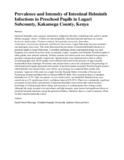| dc.description.abstract | Intestinal helminths cause anaemia, malnutrition, indigestion disorders, retarded growth, and low mental abilities in pupils. About 1.5 billion are infected globally. Intestinal helminth infections are caused by Ascaris lumbricoides, Trichuris trichiura, Strongyloides stercoralis, Enterobius vermicularis, Ancylostoma duodenale, and Necator americanus. Lugari Subcounty has poor sanitation and inadequate clean water. This study determined the prevalence of intestinal helminth infections in preschool pupils in Lugari Subcounty. A stratified multistage cluster experimental design was used. Sampling was carried out in four wards: Lumakanda, Lugari, Luandeti, and Chekalini. Preschool pupils of either gender were selected randomly. Written consents and verbal assent were obtained from parents or guardians and preschool pupils, respectively. Questionnaires were administered in order to collect sociodemographic data. Stool samples were collected and tested for the presence of eggs using the standard Kato-Katz technique. Prevalence rate and prevalence ratio were calculated as the percentage of infected preschool pupils among the total number of preschool pupils examined. Preschool pupils positive with helminths were treated freely, and a follow-up screening was conducted three months after treatment. Approval of the study was sought from the Masinde Muliro University of Science and Technology Institutional Ethical Review Board (MMUST IRB). The overall prevalence of intestinal helminths was 12.3%. Only one species, Ascaris lumbricoides, was identified. Statistical tests were carried out at a 5% significance level (, confidence interval (CI) 95%). There was a statistically significant association for prevalence and intensity of intestinal helminths versus factors like school location, knowledge of washing hands before eating, and awareness of washing hands after visiting a toilet. Although this study revealed a low prevalence and light intensity, some factors had significant effects on intestinal helminth infections among the preschool children. Therefore, there is a need to intensify efforts for their intestinal helminth control. | en_US |

